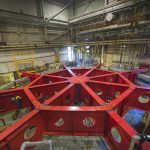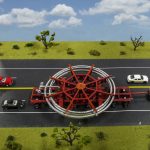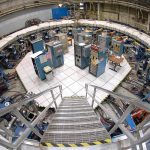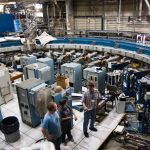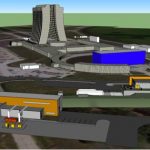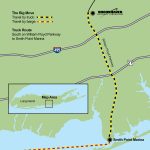Note: Fermilab and Brookhaven Lab staff will be covering the move with photos and video, and will make all materials available to news organizations. Contact Andre Salles (asalles@fnal.gov) or Peter Genzer (genzer@bnl.gov). Up-to-date information will be posted at muon-g-2.fnal.gov/bigmove.
Follow the ring’s journey from New York to Illinois online at muon-g-2.fnal.gov/bigmove
UPDATE
JUNE 13: Due to inclement weather on the east coast, the move of the Muon g-2 ring has been delayed a week. The current plan is to move the ring across the Brookhaven site on Saturday, June 22, and move it down the William Floyd Parkway to the Smith Point Marina the night of Sunday, June 23 into the morning of Monday, June 24. Stay tuned to muon-g-2.fnal.gov/bigmove for further updates.
How do you move a 50-foot-wide, circular electromagnet from Long Island to the Chicago suburbs in one piece without flexing or twisting it? Very, very carefully.
On Sunday, June 16, the electromagnet will begin its 3,200-mile land and sea voyage to its new home at the U.S. Department of Energy’s (DOE) Fermi National Accelerator Laboratory in Illinois, where it will become the centerpiece of a new experiment called Muon g-2 (pronounced gee-minus-two).
This experiment will study the properties of muons, subatomic particles that live only 2.2 millionths of a second, and its results could open the door to new realms of particle physics.
The magnet was built at the DOE’s Brookhaven National Laboratory in New York in the 1990s, where it was used in a similar experiment. The ring is constructed of aluminum and steel, with superconducting coils inside, and it cannot be taken apart or twisted more than a few millimeters without irreparably damaging those coils.
Transporting the electromagnet from Brookhaven to Fermilab will cost 10 times less than building a new one. The magnet will remain inert, exhibiting no magnetic properties, until it is plugged in at Fermilab.
The Muon g-2 team has devised a plan that involves loading the ring onto a specially prepared barge and bringing it down the East Coast, around the tip of Florida and up a series of rivers to Illinois. Once it arrives in late July, the ring will be attached to a truck built just for the move and driven to Fermilab, traveling over two consecutive nights and using rolling roadblocks to temporarily close sections of the roads.
Road closings and detours will be coordinated with public safety agencies in both states.
The trip begins Sunday morning, as the ring will be moved across the Brookhaven site to a staging area just inside its main gate. On the evening of Monday, June 17, it will be driven down the William Floyd Parkway to the Smith Point Marina, where it will be loaded onto the barge.
Members of the public can follow along on the ring’s journey on a new web page launched this week at muon-g-2.fnal.gov/bigmove. The page includes a GPS-powered map that will trace the path of the ring in real time, and a blog that will be updated with images, videos and the most current information about the move.
Public events are also in the planning stages to celebrate the ring’s arrival at Fermilab.
“It’s not often our neighbors get a ringside seat for something this complex and interesting,” said Chris Polly, Muon g-2 project manager for Fermilab. “We’re excited to get this move under way.”
For more information on the experiment, visit muon-g-2.fnal.gov.
Download an animation simulating the truck transporting the 50-foot-wide Muon g-2 storage ring through the streets of Illinois. Credit: This video is copyright Emmert International. It is available for reporters to download and use.
- Crews work to attach the red stabilizing apparatus to the Muon g-2 rings at Brookhaven National Laboratory in New York in preparation for moving them over land and sea to Fermi National Accelerator Laboratory in Illinois. Credit: Brookhaven National Laboratory
- A model of the truck that will be used to transport the Muon g-2 ring, placed on a streetscape for scale. The truck will be escorted by police and other vehicles when it moves from Brookhaven National Laboratory in New York to a barge, and then from the barge to Fermi National Accelerator Laboratory in Illinois. Credit: Fermilab
- The Muon g-2 storage ring, in its current location at Brookhaven National Laboratory in New York. The ring, which will capture muons in a magnetic field, must be transported in one piece, and moved flat to avoid undue pressure on the superconducting cable inside. Credit: Brookhaven National Laboratory.
- Physicists stand inside the Muon g-2 storage ring, in its current location at Brookhaven National Laboratory in New York. The ring is 50 feet wide, and will be transported in one piece by barge and truck to Fermi National Accelerator Laboratory in New York. Credit: Brookhaven National Laboratory
- Conceptual drawing of the buildings on the Fermilab site that will host the new Muon g-2 and Mu2e experiments. Credit: Fermilab
- This map shows the route the Muon g-2 ring will take from Brookhaven National Laboratory in New York to the barge that will bring it to Illinois. The ring will be transported on a truck that will move no faster than 10 miles per hour, and rolling roadblocks will be used to close portions of the road as the truck moves through. Credit: Brookhaven National Laboratory
Fermilab is America’s premier national laboratory for particle physics research. A U.S. Department of Energy Office of Science laboratory, Fermilab is located near Chicago, Illinois, and operated under contract by the Fermi Research Alliance, LLC. Visit Fermilab’s website at www.fnal.gov and follow us on Twitter at @FermilabToday.
One of ten national laboratories overseen and primarily funded by the Office of Science of the U.S. Department of Energy (DOE), Brookhaven National Laboratory conducts research in the physical, biomedical, and environmental sciences, as well as in energy technologies and national security. Brookhaven Lab also builds and operates major scientific facilities available to university, industry and government researchers. Brookhaven is operated and managed for DOE’s Office of Science by Brookhaven Science Associates, a company founded by the Research Foundation for the State University of New York on behalf of Stony Brook University, the largest academic user of Laboratory facilities, and Battelle, a nonprofit applied science and technology organization.
The DOE Office of Science is the single largest supporter of basic research in the physical sciences in the United States, and is working to address some of the most pressing challenges of our time. For more information, please visit science.energy.gov.

